Part 1
Guide 1. (Lights a candle)
We will not forget that very black year...
And no matter how many generations change,
And no matter how much adversity there is in life,
We cannot avoid sorrowful reflections...
This exposition was created by teachers, students and parents of our lyceum in order to preserve the historical truth and memory of the tragic events of the Second World War, when our people were subjected to terrible torture and suffering. On the territory of Belarus during the Second World War, the Nazis carried out a full-scale policy of Genocide - the systematic extermination of target groups of the population for one reason or another. The fascists created more than 260 death and mass extermination camps, 14 of them for children on the our Belarusian land.
It is impossible to look at archival photographs of such places without pain and trembling. Years later, children's hungry and exhausted eyes behind the barbed wire convey to us all the horror and suffering of these children, and do not allow us to forget the sorrowful moments of our history...
At the beginning of our exposition we tried to recreate the atmosphere of a concentration camp. On the shelves, were stylized as camp bunks on which people slept in several storeys, we placed things, dishes, and objects that could be used by both prisoners and guards of such camps.
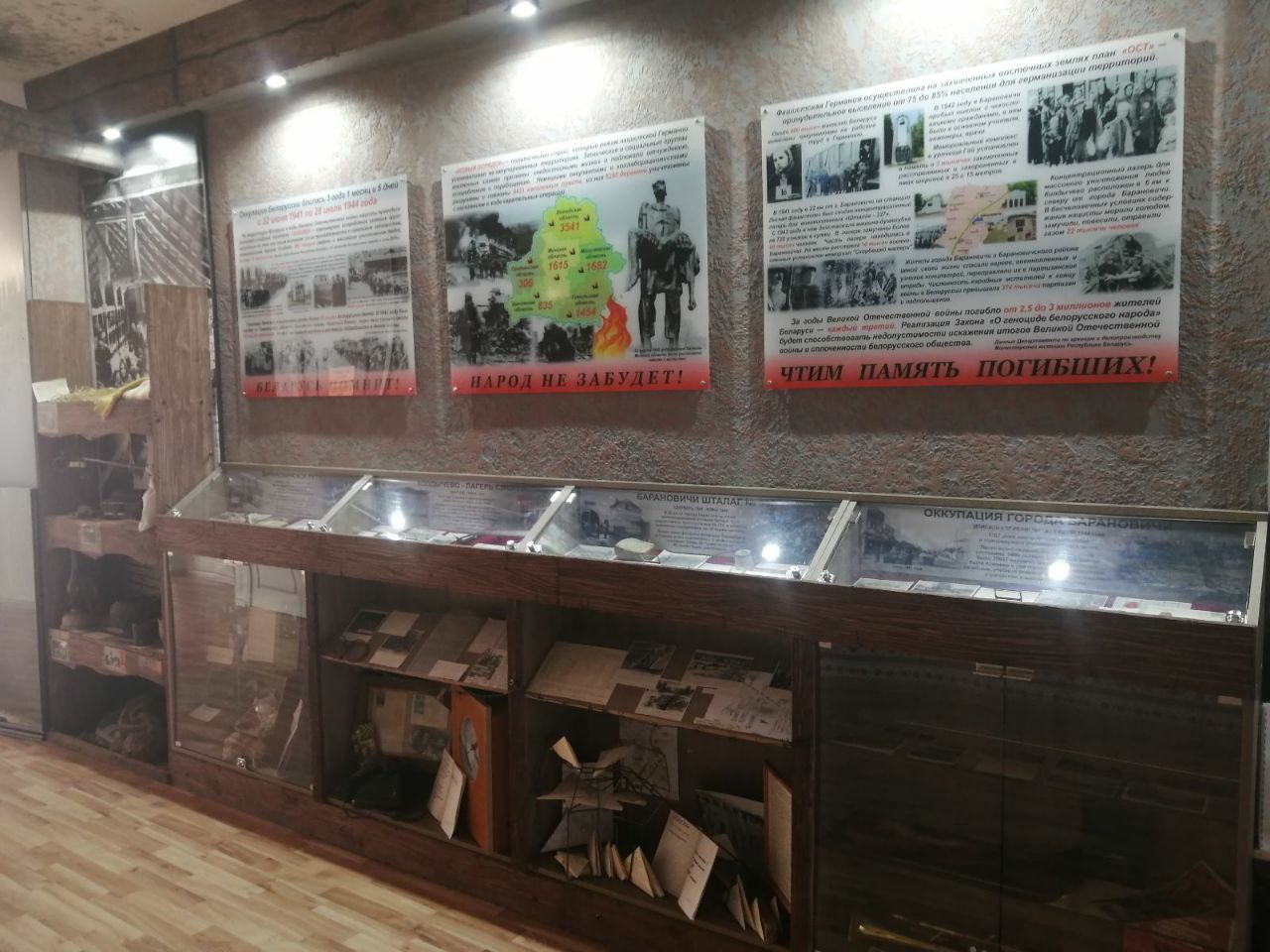
Often in concentration camps, prisoners were forbidden to havе personal things at all. From the memoirs of concentration camp prisoners, we know that “The working day for prisoners lasted 10–12 hours a day, those who could not withstand such a load or fell were killed there…. They slept on bunks covered with straw and placed in 3-4 storeys.” The daily bread ration in most concentration camps was 140 grams in 1942, and in 1943 the bread ration was reduced to 110 grams. In addition to flour, seventy percent sawdust was added to the bread. But this was not the worst thing. From the memoirs of Stanislav Vysokinsky, a villager of the Novomyshsky region.
“In camp No. 337 there were absolutely no amenities, there were no basic bunks or stoves, and a lot of snow blew through the cracks. The barracks could not accommodate all the prisoners of war. In the winter of 1941 and 1942, most of the prisoners were in the open air when the temperature was minus 20.”
From the memoirs of Polish officer Samuel Willenberg:
“In January 1943, I ended up in a barracks where the women were getting their hair cut in front of the gas chamber. And here is such a girl sitting in front of me. And she quietly asks me how long this path to death will last. I told her that it took ten minutes, maybe less...
I told her lies, in fact the whole process took longer. She told me that she had recently passed her final exams and so she stood up , put her amulet on the chair - a rag doll, and went to the door ... "

“On July 9, 1941, the residents of Baranovichi were given an order from the military commandant to make an indemnity of 5 kg of gold and 10 kg of silver and 1 million Soviet rubles. Everyone had to contribute the gold they had (rings, signets, gold or silver items, coins). The collections of soap (laundry and toilet) and new items were also mentioned. Under the threat of shooting all the valuables were handed over. The occupiers carefully weighed, counted and recorded all the collected stuff in the special journals.”
On June 22, 1941, the life of all the Soviet people was divided into “BEFORE” and “AFTER”. The last minutes of peaceful life... "Today is Sunday, we are going to the park and going by boat!" But such simple human plans were not destined to come true...
“AFTER” was life “under the Germans’ pressure ”... This part of the exhibition is contact, it contains letters from the children who were in the concentration camps, which you can touch and you can...NO, YOU MUST read!
A tour of the exposition of Lyceum No. 1 (part 2)
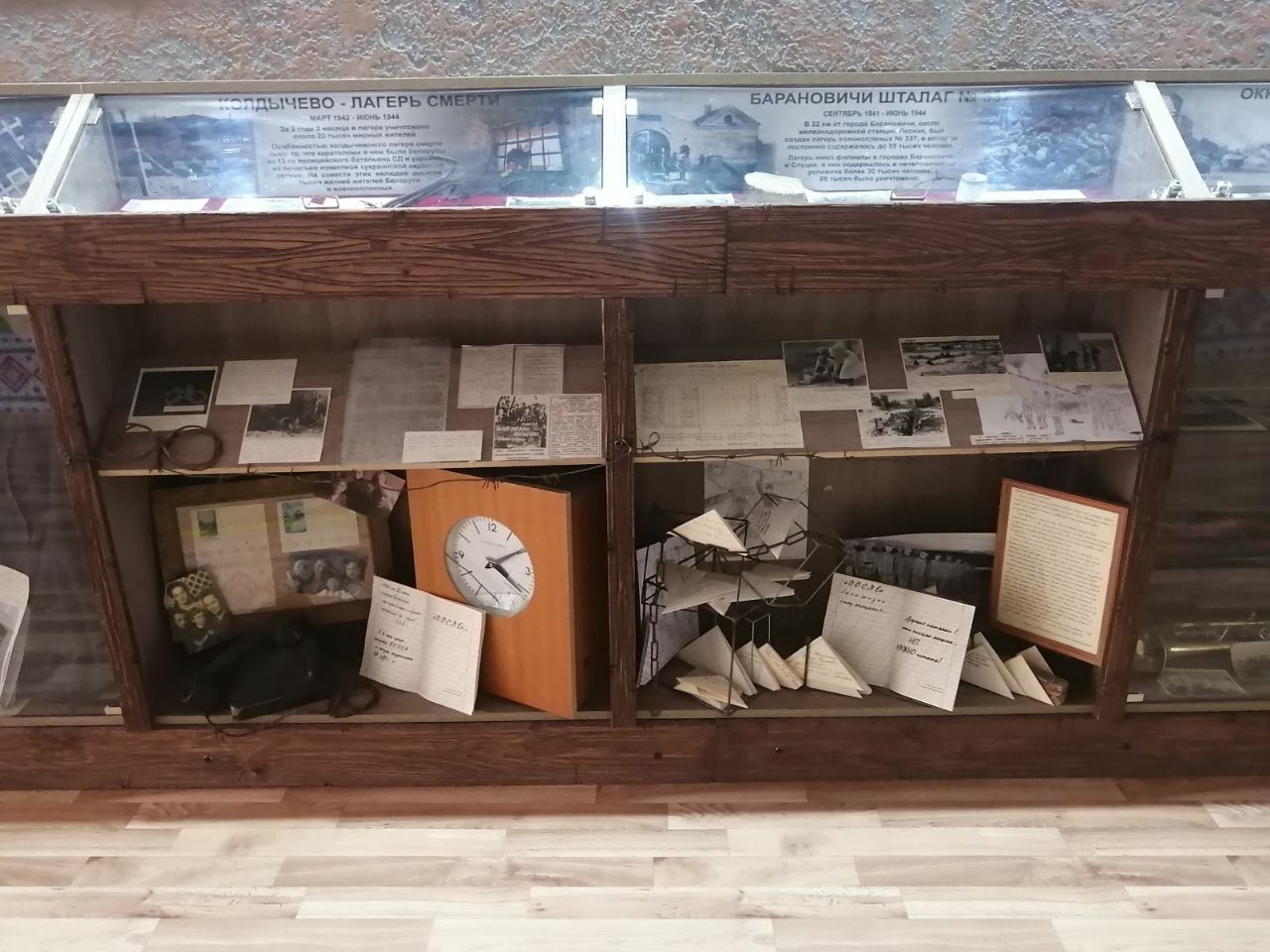
On June 27, the Nazis entered our town, and the territory of the Baranovichi district was also occupied. From the very first minutes, the fascists showed that they were the masters here. They were located in the best buildings of the town and determined the fate of the town and its residents.
At that terrible time, the residents of our town and the surrounding area learned what it meant to be a representative of the "lower race".
On June 28, 1941, in two hours, all the Jews of the town of Baranovichi were forcibly evicted to the so-called "Sakhalin" (the area near the current household chemicals plant). They were allowed to take only a bundle of the most necessary things with them. Everyone was forced to leave all their possessions. The yellow cloth sign outlawed the Jews — no one was responsible for their beating, robbery, murder.
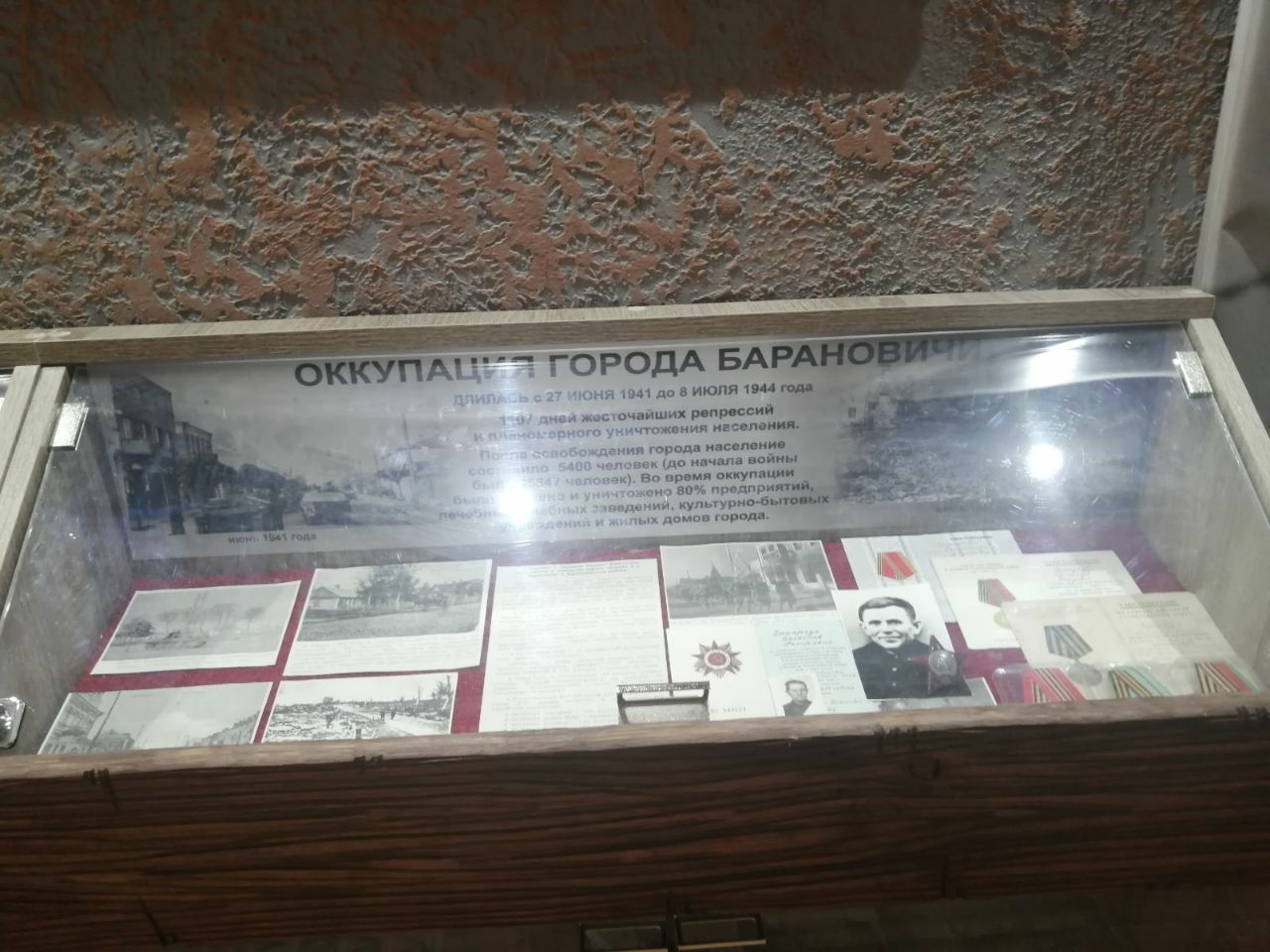
In December 1941, a Jewish ghetto was established in Baranovichi. Herded into a certain area, the ghetto occupied 11 blocks of Baranovichi and was limited to modern Gagarin, Komsomolskaya, Lisin, Bogdanovich streets. The gate was built at the intersection of the current Gritsevets and Mitskevich streets, where the branch of the toy production association Mir is now located.
The Jews could take only one suitcase with their personal belongings to the ghetto. They were forbidden to leave the ghetto area without special permission, thereby depriving them of the opportunity to earn a piece of bread. The Jews were forbidden to walk on the sidewalks, but only in the middle of the street, it was forbidden to use public transport, to be in parks and public places. The Jews were required to have a yellow distinctive sign in the form of a six-pointed Star of David on both sides of their clothes (front and back). The ghetto was surrounded by two rows of barbed wire and was strictly guarded. By December 1941, there were 15,000 people in it.
"People in the ghetto were always hungry. The Germans starved the residents, allowing them to buy only a limited amount of bread and potatoes. Some managed to save some money or valuables, and they exchanged them for food smuggled into the ghetto.
"From the memoirs of a survived prisoner of the Baranovichi ghetto, E.A. Madresh:
"Despite suffering and death, the ghetto children continued to play with toys, making them themselves, from any scraps of cloth and a piece of wood they could find."
Escaped prisoners of concentration camps and ghettos were rescued by priests of Orthodox churches and priests of Catholic churches.
But this was not enough for the Nazis , they destroyed almost all the Jewish population of the town, villages and towns of the Baranovichi district.
At the end of December 1942, a Judenfrei sign "JUDENRAYN" ("Free from Jews") was installed at the entrance to the town of Baranovichi.
In total, 18750 people were killed from the Baranovichi ghetto — Soviet citizens of the Jewish nationality, including 12 thousand residents of Baranovichi.
On December 23, 2002, a memorial sign was unveiled in the square near the House of Officers, the place where the ghetto border was located, to twelve thousand residents of Baranovichi who died in the ghetto.12 fallen maple leaves made of metal, scattered around a huge boulder, preserve the memory of 12 thousand Jews who were shot.
The Holocaust is a terrible page in human history. The Nazis murdered millions of Jews across Europe. But in those "dark times of mankind" there was a place for heroism. These were the Righteous of the nations of the world. In the Talmud, one of the main books of Judaism, it is stated that “the one who saved one life saved the whole world.” More than 680 people have been recognized as righteous for saving the Jews on the territory of modern Belarus. In the Brest region, 27 residents have been awarded this title , seven of them are the residents of Baranovichi: Edward Chascha, Anna Kazakevich, Leopold Slizen, Tatiana Mandel, Galina Abramova, Roman Malinovsky, Sophia Malinovskaya.
The names of people awarded this high title are inscribed on the Wall of Honour in the Garden of the Righteous among the Nations of the World in the Memorial Museum in memory of the Jews who died during the War. In honour of everyone awarded this title, a tree is planted on the Alley of the Righteous of the Nations of the World, on which a memorial plaque is installed with a story about a wonderful man who was in danger and who lived in constant fear, but still saved the Jews from death.
A tour of the exposition of Lyceum No. 1 (part 3)
Indisputable evidence of the policy of genocide were two camps that existed near Baranavichy. This is the Koldychevsky death camp and Stalag-337.
In the 15 kilometers from the city of Baranovichi, on the territory of the former Panjskij estate in the village of Koldychevo from March 1942 to July 1944, a camp created by fascists for civilians operated. During the two years of its existence, the concentration camp killed about 22,000 civilians, residents of the city of Baranovichi and Baranovichi district. In our exposition we placed models of patches worn by the prisoners of this camp. Upon arrival at the camp, the prisoners were required to put on their clothing special signs differentiating them according to the degree of danger to the occupation authorities. The signs were worn on the back and chest, and the men were also worn on the right side of the pants. The danger was determined by the number of light stripes. The dark blue, with one light stripe - suspected links to the guerrillas, two stripes - was associated with the guerrillas, three stripes - the guerrillas; the black stripe with the yellow hexagon marked "Jew".
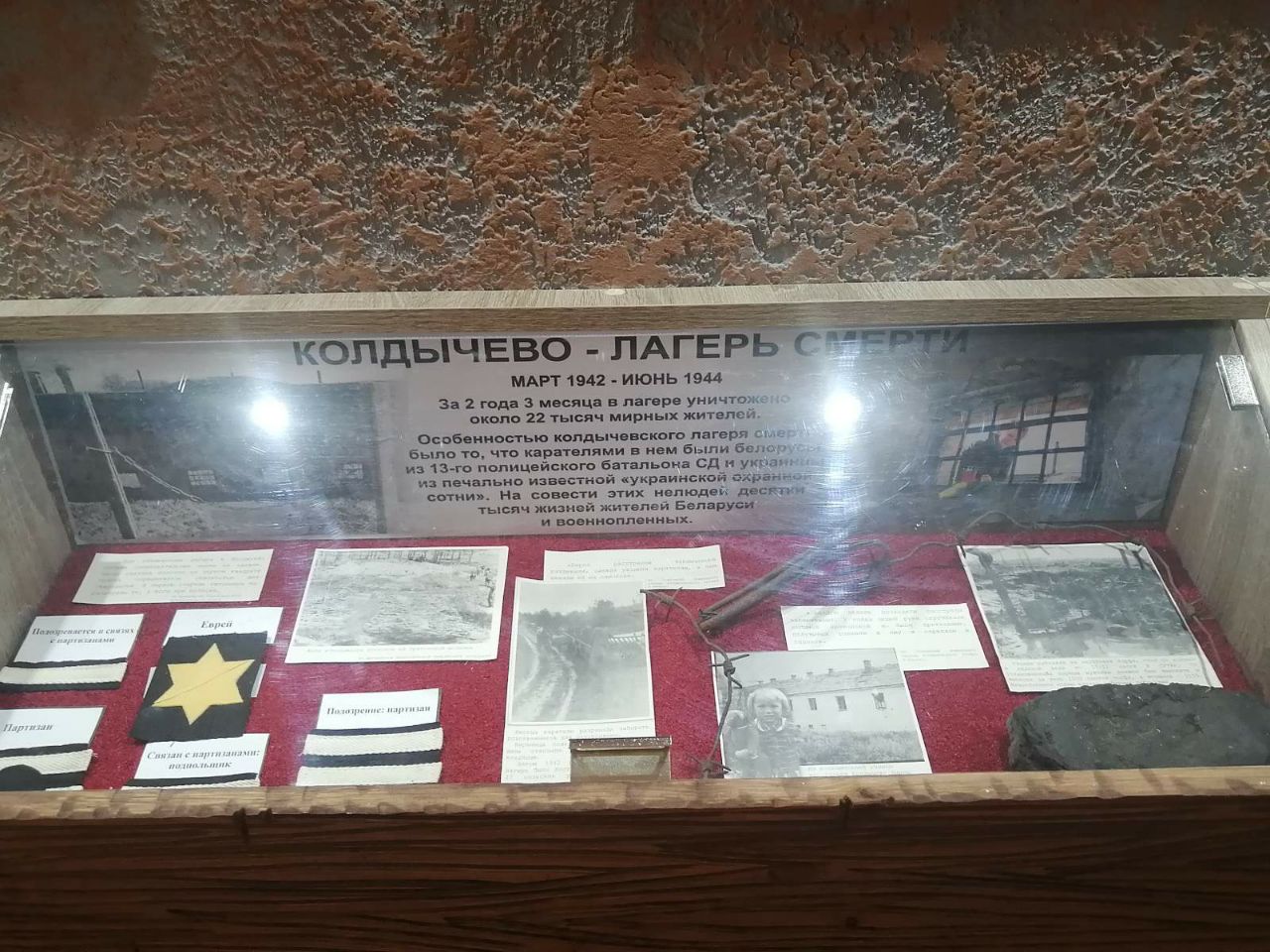
Why were peaceful people sent to the camp?For the fact that their relatives went to the front or to join partisan detachments, for the Red Army uniforms not handed over to the Nazis, for appearing on the street after eight o’clock, for not wanting to bow their proud heads to the occupiers, for any “offences”, or evenjust for no reason.In the summer of 1942, 13 priests and 37 Polish teachers were brought to the Koldychevsky camp.Everyone was shot. The camp area was fenced in several rows with barbed wire and equipped with machine gun nests.At night, security was reinforced by additional firing points and patrol units around the camp, and was provided by bunkers and tanks dug into the ground. Camp prisoners were housed in barracks and outbuildings.The specially built prison had 12 cells.About 60% of the prisoners of the Koldychevo camp were in the open air.
Prisoners of the Koldychevsky camp worked on brick, soap-made, cooper production, as well as on the fields and peat mining, loaded metal and building materials. The working day in Koldychevo was 10-12 hours. The lifting in the camp was carried out at 6 a.m. After lifting, the prisoners were checked. In total, at least 9 inspections were carried out during the day. All of them were accompanied by beatings and abuse of prisoners. Near the prison, a two-storey wooden house was occupied by a commandant and a guard. Torture chambers were also located there, where the victims were subjected to terrible torture. Their tongues were pierced, needles were pressed under their nails, they were hung, muscles were stretched, fingers and toes were broken, rubber truncheons were beaten, water was poured into the nose, water was pressed into the head with a special loom, body pieces were cut with knives and bayonets were stabbed, naked feet were placed on a hot pan, They tore their hair, set them up with specially trained dogs.
From the testimony of the commander of the Koldychevsky camp N.Kalko:
«Before the execution of prisoners stripped, clothes went to the punishers, and they changed it for moonshine».
... there were shootings of prisoners every week. In naked people hands twisted barbed wire and beat with rifle butts, half-living pushed into a pit and shot in the head».
From the memories of the Belarusian poet Sergei Novik-Pyayun:
«I don’t have the strength to describe all the horrors, the bullying, the torture I had to endure in the SD cells. I can’t explain how I survived, how I survived. The German mockingly introduced me to camp commander Nikolai Kalko: «Look, Lieutenant, here is the Russian poet». And immediately began the beating. In the «reception rest» on the wall, as a sausage in the butcher shop, hanging rubber clubs of various sizes».
On the site of the mass grave where the last thousand prisoners were shot before the retreat was erected a monument in the form of skulpura to the grieving mother. But in the woods near Koldychevo Soviet investigators in 1945 found 15 more similar tombs. On July 3, 2007 on the fifteenth kilometer of the highway Baranovichi - Novogrudok at the entrance to the Mikhnovich forest between the villages of Koldychevo and Mikhnovschina, a memorial sign «The Wailing Wall» was opened by presidential decree. The monument is a three-fold arch on which the Star of David, Orthodox and Catholic crosses are installed.
CABINET 3 STALAG 337
Stalag-337 was one of the largest camps for Soviet prisoners of war that the Nazis established in September 1941. It was located in the area of Lesnaya station, a branch of the camp was located in Baranovichi prison. Stalags Germans called stationary camps for prisoners of war. In three years, 88,407 Soviet prisoners of war and civilians were killed in the camp.
The conditions of the camps, the treatment of the prisoners were designed to kill the will to resist, to humiliate human dignity and to destroy them physically. The camps were fenced with several rows of barbed wire and reinforced with searchlights and specially trained dogs.
Prisoners were not allowed to communicate with the outside world, and food was not allowed. Prisoners were shot for trying to obtain anything from food or clothing.
From the memories of S. Vysokinsky, a resident of Novomiskiy district:
«People took turns in barracks. They fed them with balanda and gave them 125 grams of bread a day. Prisoners were subjected to unprecedented torture».
The brutality in the concentration camps was welcomed, and people were biological material for the Nazis and had to be destroyed. The effaceurs of the civilian population were rewarded for their atrocities. But a fair trial was held.
From the material of the Baranovich inter-district prosecutor’s office:
The mud huts, which housed prisoners of war, were unsuitable for housing, damp, cold. Poorly dressed and worn sent for the most difficult work on the St. Forest for loading and unloading. Many died from frostbite.
Prisoners of war often suffered from mass starvation and death and infectious diseases. The water in the camp was insufficient and those trying to get water were severely beaten.
On May 9, 2005, a memorial complex «Memory» was opened at the burial place of 31 thousand Soviet prisoners of war who died in Baranovichi prison.
A tour of the exposition of Lyceum No. 1 (part 4)
(maps of burned villages)
One of the forms of genocide was the policy of burnt lands pursued by the Germans in the occupied territories.During the period of occupation, more than 140 major punitive operations were carried out in Belarus against partisans and civilians.One of the main methods and methods of implementing the punitive “scorched earth” policy was the mass destruction of settlements along with the population.As a rule, the Nazis herded people into one house, barn or barn, closed it tightly, and then set it on fire.
Based on information received during the investigation by the General Prosecutor's Office of the criminal case of genocide of the population of Belarus, which was initiated in April 2021, maps were published.They contain information about the location of settlements on the modern territory of the Republic of Belarus, burned by the fascist occupiers and their accomplices during the Great Patriotic War.
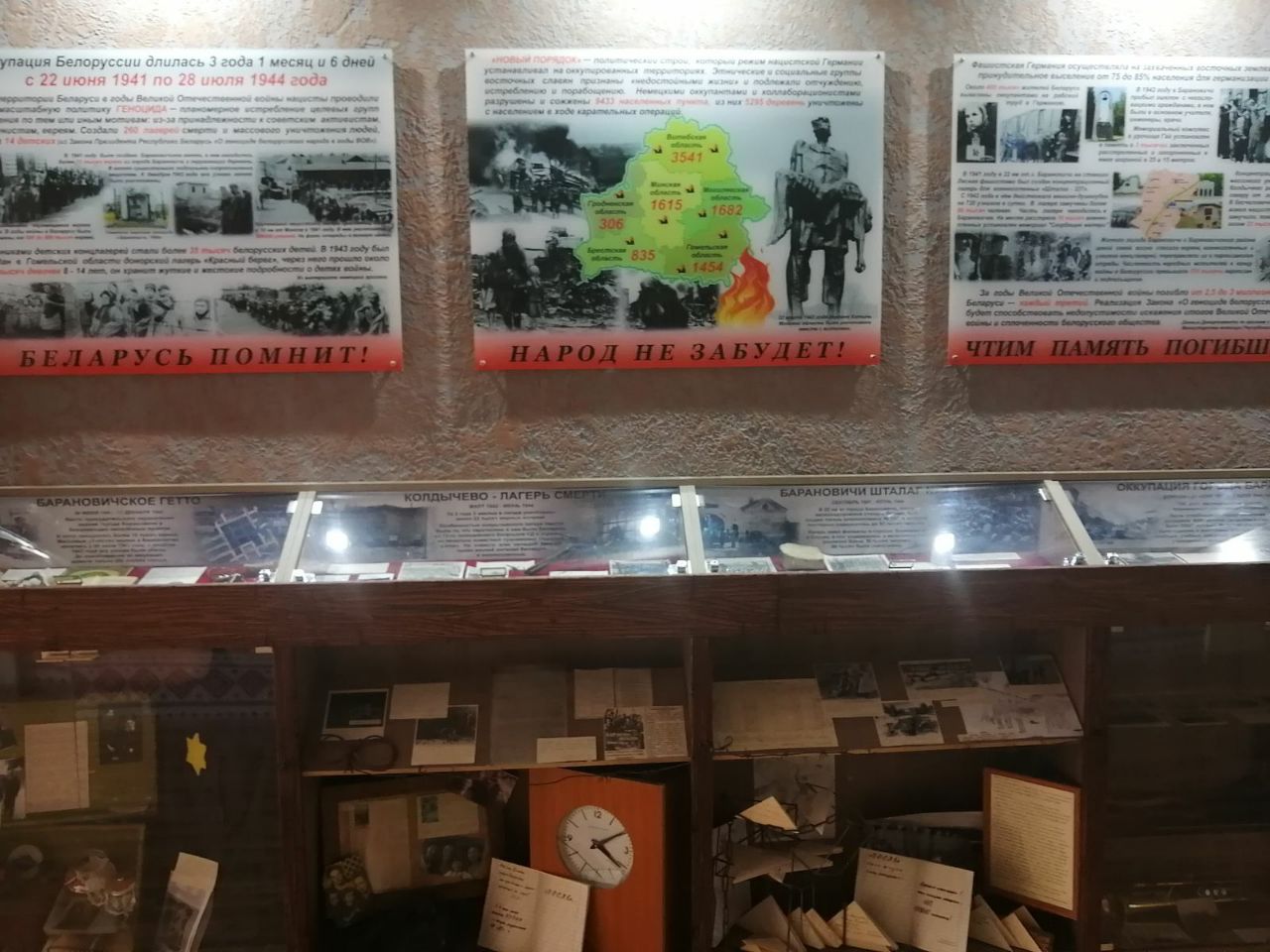
In this part of the exhibition we see a map that actually burns based on the number of burnt villages in Belarus marked with red dots.The following figures speak about the scale of the destruction of populated areas of Belarus by the fascist invaders along with their residents: the punitive forces burned over 9,000 (!) rural settlements.Many were not revived.The Nazis destroyed almost 5,300 villages and hamlets, including all or part of their inhabitants.
The Great Patriotic War left a terrible mark on the Baranovichi land.It swept through peaceful villages like a tornado of fire, destroying people and burning everything that the hardworking villagers had created.In the Brest region during the Great Patriotic War, punitive forces burned 786 villages, in the Baranovichi region - 56 villages.The second map shows the burned villages of the Baranovichi region, the number of houses and people who were there before the war, how many houses were destroyed and people killed.The fourth generation here has not known war.But the memory of the terrible past lives in our hearts.
CABINET 4 OCCUPATION OF BARANOVICHI
This part of the exhibition tells about the horrors of the occupation of our city, photos, evidence, documents, personal belongings of the participants in those events.
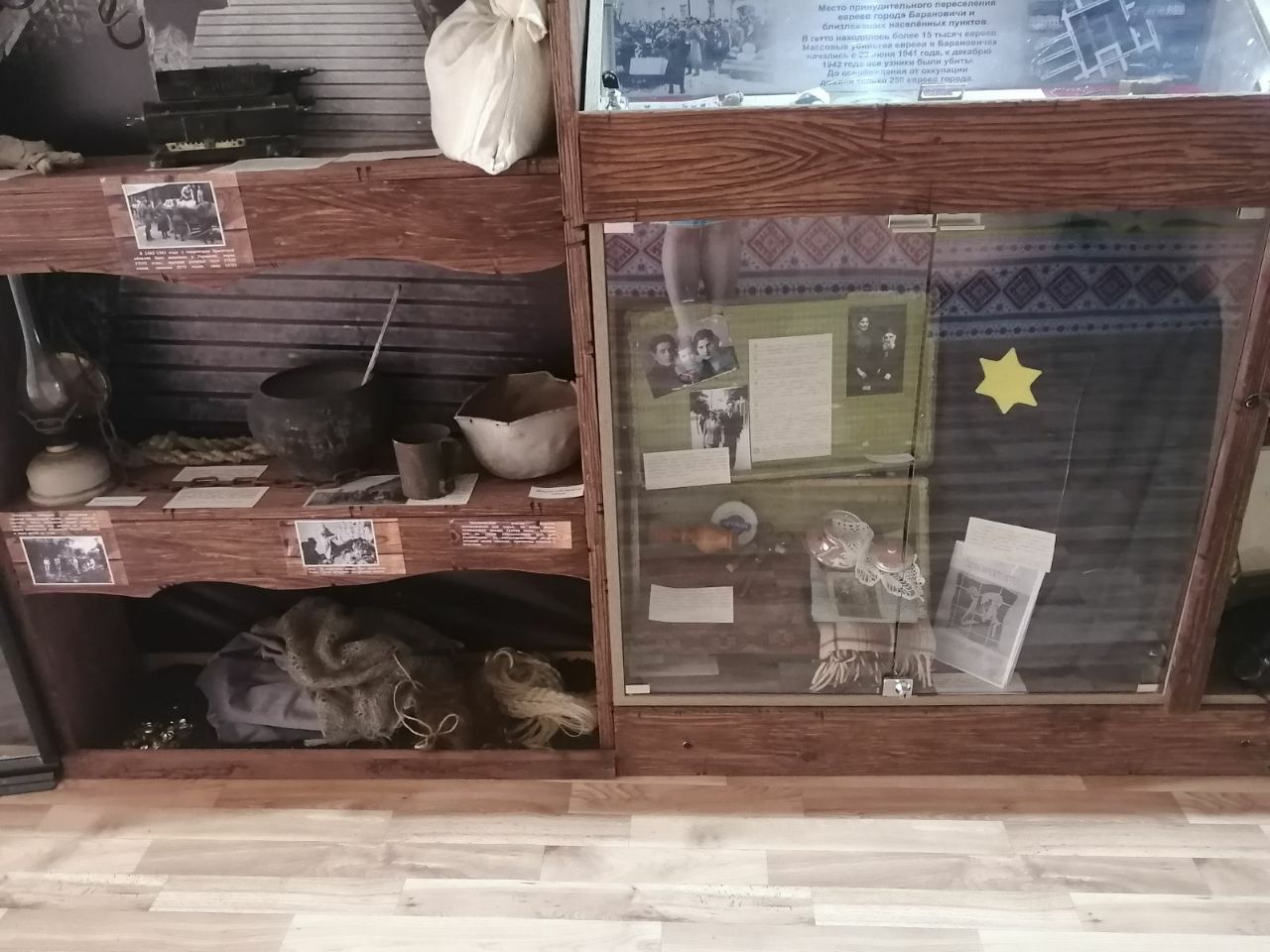
In April 1942 in the city of Baranovichi in houses on the str.Vilenskaya and str.Shosseynaya, on the instructions of the head of the Baranovichi SD-Gestapo, two special selection points were created for the forced sending of people into German slavery.These points existed until June 1944, and 300–400 people were sent from them every month.From the city of Baranovichi, according to incomplete data, 7,593 people were sent to hard labor in Germany.
According to the State Commission for Accounting for Damage Caused by the Nazi Invaders, on the territory of the former Baranovichi region they destroyed:
181,179 civilians,
88,407 Soviet prisoners of war,
33,773 inhabitants were taken into German slavery.
We see terrible numbers from the “Information on the genocide of the Nazi invaders against civilians in the city of Baranovichi and the Baranovichi region”
After the war, in January 1962, in the city, in the hall of the House of Officers, a trial was held of 4 Nazi criminals, guards of the Koldychevsky camp.Witnesses to the crimes of the Nazis came from all over Belarus.Judging by the photo, there were no empty seats in the hall.The atrocities that the defendants and their colleagues committed during the war are well preserved in people's memory.More than fifty witnesses spoke at the trial.For six days people watched the trial and demanded the death penalty.After all, there could be no other sentence for the executioners.Digitized records of this trial are stored in the Baranavichi Museum.
The city of Baranovichi was liberated on July 8, 1944.We can say that the Great Patriotic War almost completely destroyed pre-war Baranovichi.80% of all city buildings were destroyed.The railway, the power plant, almost the entire city industry, 2.5 thousand residential buildings, a drama theater, a cinema, six schools, one of the largest radio stations in the country were destroyed, a museum was looted... The pre-war population was more than 26 thousand people and only a little more than 5 thousandThe townspeople met their liberators: the troops of the 1st Belorussian Front under the command of Marshal of the Soviet Union K.K. Rokossovsky.At the same time, the troops of the 28th Army under the command of Lieutenant General L.A. Lupinsky and the 65th Army under the command of Colonel General P.I. Batov distinguished themselves.The partisans of the Baranovichi unit also entered the liberated city along with the troops.
And now I want to tell you about a man, a WWII veteran, whose personal belongings are displayed in our exhibition.
Vladimir Ivanovich Sazanovich
Vladimir Ivanovich was born on August 2, 1922 in the village of Slonevo, Novogrudok district. He studied at a Polish school, finished 8 forms, and there he learned to play the violin. In 1944, after the liberation of Belarus, he and his two brothers were drafted into the Red Army. He liberated the city of Koenigsberg (today Kaliningrad). In the army, he was a radio operator, maintaining contact between the regimental headquarters and the advancing unit. During the offensive, this connection was interrupted, and together with the unit commander Vladimir went to restore it. But they were covered by a shell. The commander was killed and Vladimir was wounded in the leg. Solders bandaged his leg, gave him a stick in his hands and told him to walk to the rear. He was picked up behind the lines and admitted to the hospital. Since he was bleeding heavily he lost a lot of blood. Luckily, one nurse agreed to give him a blood transfusion and he was saved. In the hospital one officer had a trophy - a German violin. Vladimir often played it for the wounded, and when he was discharged from the hospital home, he received this violin as a gift.
After many years, with the help of the Red Cross, Vladimir found the nurse who saved his life. He went to Moscow to meet her and thank her. He earned his living by playing the violin. Today his violin is over 100 years old and is kept by his great-grandson.
After the war, Vladimir got married and had 2 sons. He worked as a postman, a tailor, and on weekends he played the violin at weddings throughout the Novogrudok region. Vladimir Ivanovich lived a long and interesting life. Died on September 3, 2009 at the age of 86.
Vladimir Ivanovich had 4 grandchildren and 7 great-grandchildren. Two grandchildren Inna and Alexander Sazanovich are graduates of the lyceum in 1991 and 1997. His great-grandchildren Maria and Nikolai Bondar studied here, and Ivan Bondar continues the tradition and studies in grade 9-1.
In April 2021, the Prosecutor General's Office opened a criminal case on the fact of genocide of the population of Belarus during the Great Patriotic War and the post-war period. Employees of the prosecutor's office found thousands of documentary evidence of the atrocities of fascism, and interviewed hundreds of Belarusians. The Baranovichi Interdistrict Prosecutor's Office was also actively involved in the work of collecting evidence. During the investigation of this criminal case, 26 places were identified in the Brest region in which war victims, information about which was previously unknown, could presumably be buried.
In the Brest region, new evidence of the genocide of the Belarusian people during the Great Patriotic War continues to be revealed. In the Baranovichi district alone, three previously unrecorded sites of mass extermination of civilians by punitive forces were found. One of these is in a forest area near the village of Tartaki. Now servicemen of the 52nd separate search battalion of the Ministry of Defense are conducting excavations there, and prosecutors are carrying out the necessary investigative actions. The search for witnesses and the study of archival documents previously carried out by the prosecutor's office helped establish a new fact of atrocities by the occupiers.
We live in a peaceful country and take peaceful life for granted. But it was not always so. Belarusians are one of the nations most affected by the Great Patriotic War. Having occupied the territory of Belarus in the summer of 1941, the fascist invaders began to pursue a policy of genocide aimed at exterminating the Belarusian people. As a result of the genocide on the territory of the BSSR, more than 2 million 200 thousand Soviet citizens died. More than 377 thousand were captured to Germany under threat of death. Many of them died as a result of unbearable working conditions, deprivation, and abuse.
This cannot be forgotten. This cannot be forgiven. This needs to be remembered. Therefore, on January 5, 2022, the Law of the Republic of Belarus “On the Genocide of the Belarusian People” was adopted.
At the end of our exposition, we posted photos of the most famous monuments and memorials of the Second World War which preserve the truth about that distant war for future generations.
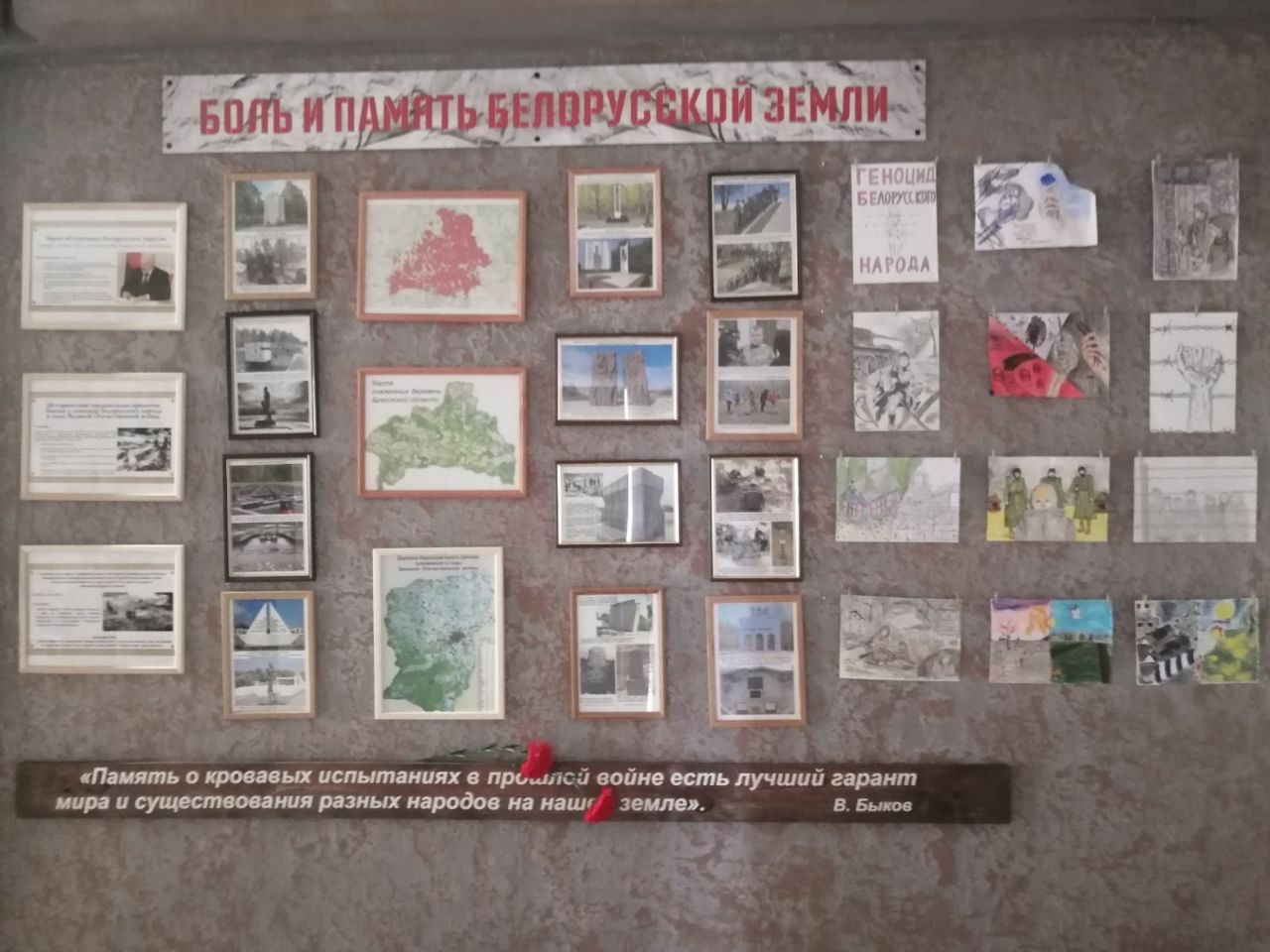
Also you can see the drawings made by students of our lyceum in which their empathy for the ancestors, their attitude and emotions towards those tragic moments in our history are expressed.
Thank you for your attention!
Recorrido por la exposición del Liceo№1
Guía 1. (Enciende la vela)
No olvidaremos ese año tan negro...
Y no importa cuántas generaciones cambien,
Y por más adversidades que haya en la vida,
No podemos evitar reflexiones tristes...
Esta exposición fue creada por los profesores y alumnos de nuestro Liceoy les ayudaban sus padres para preservar la verdad histórica y la memoria de los trágicos acontecimientos de la Gran Guerra Patria, cuando nuestro pueblo fue sometido a terribles torturas y sufrimientos. En el territorio de Bielorrusia durante la Gran Guerra Patria, los nazis llevaron a cabo una política de genocidio a gran escala: el exterminio sistemático de la población por una u otrarazón. Sólo en nuestra tierra bielorrusa, los fascistas crearon más de 260 campos de muerte y exterminio masivo, 14 de ellos eran para los niños.
Es imposible mirar fotografías de archivo de esos lugares sin sentir dolor y temblor. Los ojos hambrientos y exhaustos de los niños detrás del alambre de púas nos transmiten trasaños todo el horror y el sufrimiento de estos niños, y no nos permiten olvidar los momentos dolorosos de nuestra historia...
Al comienzo de nuestra exposición intentamos recrear la atmósfera de un campo de concentración. En los estantes, estilizados como tarimas de campo, en las que la gente dormía en varios niveles, colocamos cosas, platos y objetos que podrían ser utilizados tanto por los prisioneros como por los guardias de dichos campos.
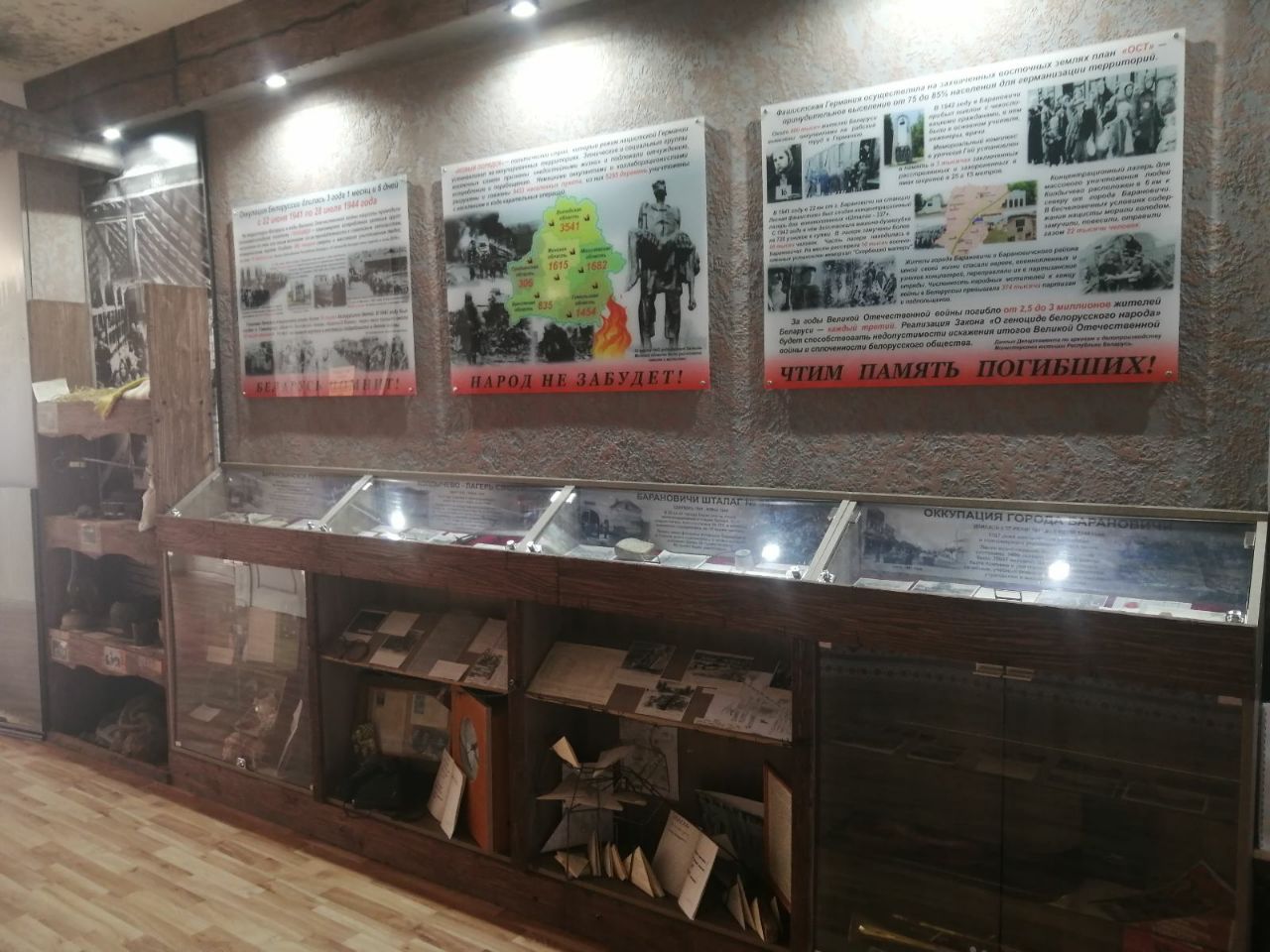
A menudo, en los campos de concentración, a los prisioneros se les prohibía tener cosas personales. Por los recuerdos de los prisioneros de los campos de concentración sabemos que «La jornada laboral de los prisioneros duraba entre 10 y 12 horas diarias, los que no podían soportar tal carga o caían eran asesinados allí mismo... Dormían en tarimas dispuestas en 3 o 4 nivelescubiertas de paja». La ración diaria de pan en la mayoría de los campos de concentración era de 140 gramos en 1942, y en 1943 la ración de pan se redujo a 110 gramos. Además de la harina, al pan se le añadía un setenta por ciento de aserrín. Pero esto no fue lo peor. De las memorias de Stanislav Vysokinsky, habitante del distrito Novomyshsky:
«En el campamento № 337 no había absolutamente ninguna comodidad, no había tarimas, ni estufas básicas y mucha nieve se colaba por las grietas. Las barracas no podían albergar a todos los prisioneros de guerra. En el invierno de 1941 y 1942, la mayoría de los prisioneros estaban en pleno aire con 20 grados bajo cero».
De los recuerdos del oficial polaco Samuel Willenberg:
«En enero de 1943 caí en una barraca donde a las mujeres les cortaban el pelo antes de ser asfixiados en la cámara de gas. Y aquí está una chica sentada delante de mí. Y me pregunta en voz baja cuánto durará este camino hacia la muerte. Le dije que diez minutos, tal vez menos...
Mentí, en realidad todo el proceso tomó más tiempo. Me dijo que recientemente había aprobado sus exámenes finales y después se levantó del taburete, puso su amuleto, una muñeca de trapo, y se dirigió a la puerta ... »
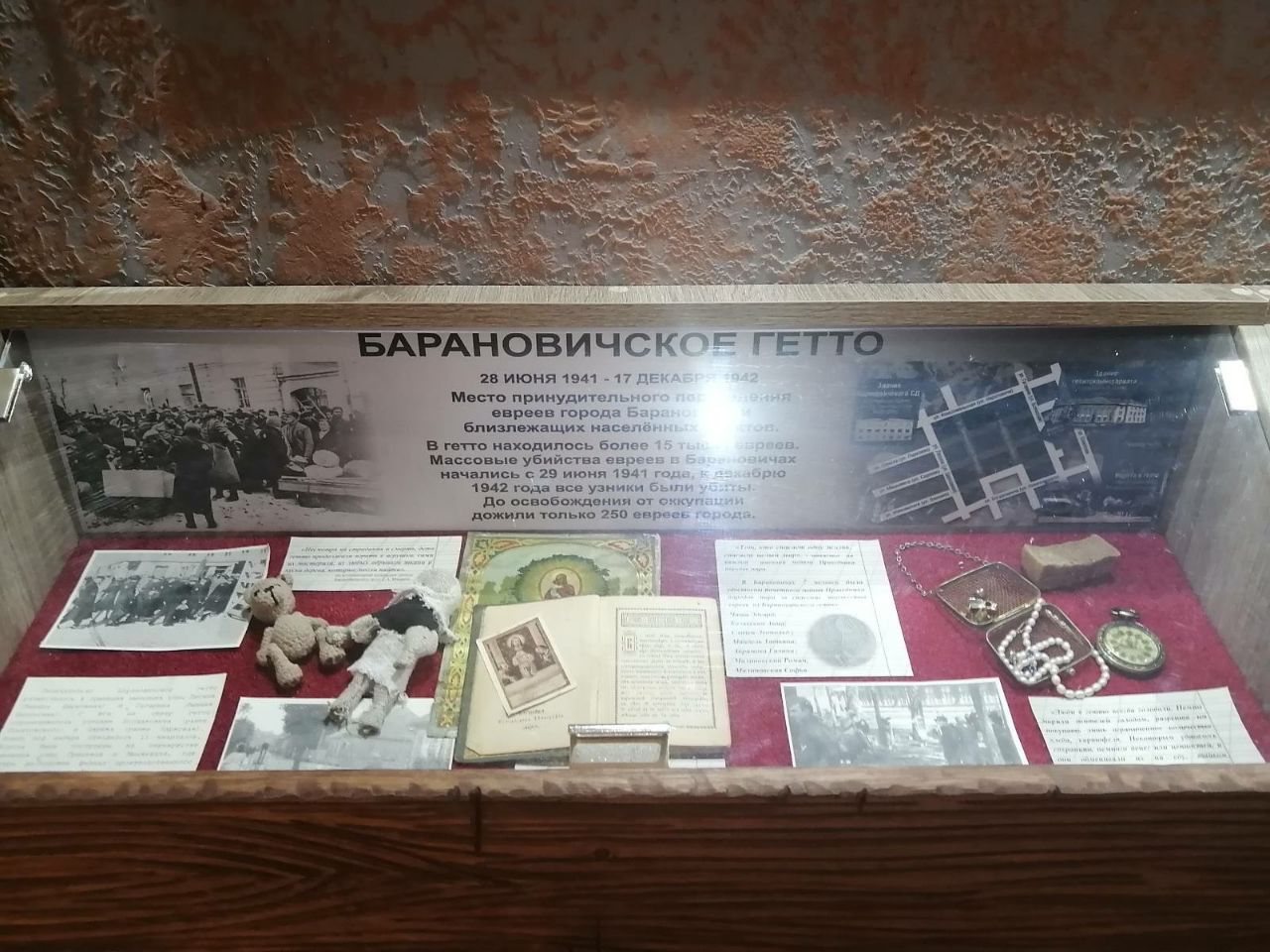
«El 9 de julio de 1941, los habitantes de la ciudad de Baranovichi recibieron la orden del comandante militar de pagar una indemnización de 5 kg de oro, 10 kg de plata y 1 millón de rublos soviéticos. Cada uno debía aportar el oro que tenía (anillos, objetos de oro o plata, monedas). También se anunciaron recogida de jabón (de lavar y de tocador) y cosas nuevas. Bajo la amenaza de fusilar a los rehenes, se entregaron todos los objetos de valor existentes. Todos los objetos de valor recolectados los ocupantes pesaron, contaron y registraron cuidadosamente en diarios especiales».
El 22 de junio de 1941, la vida de todo el pueblo soviético se dividió en «ANTES» y «DESPUÉS». Los últimos minutos de vida tranquila... «¡Hoy es domingo, vamos al parque a pasear en bote!» Pero los planes humanos tan simples no eran predestinados a llegar a realidad...
«DESPUÉS» era la vida «bajo los alemanes»... Esta parte de la exposición es de contacto, contiene cartas de niños de campos de concentración, que se puede tocar y se puede leer... ¡NO, SE DEBE leer!
Recorrido por la exposición del Liceo №1 (parte 2)
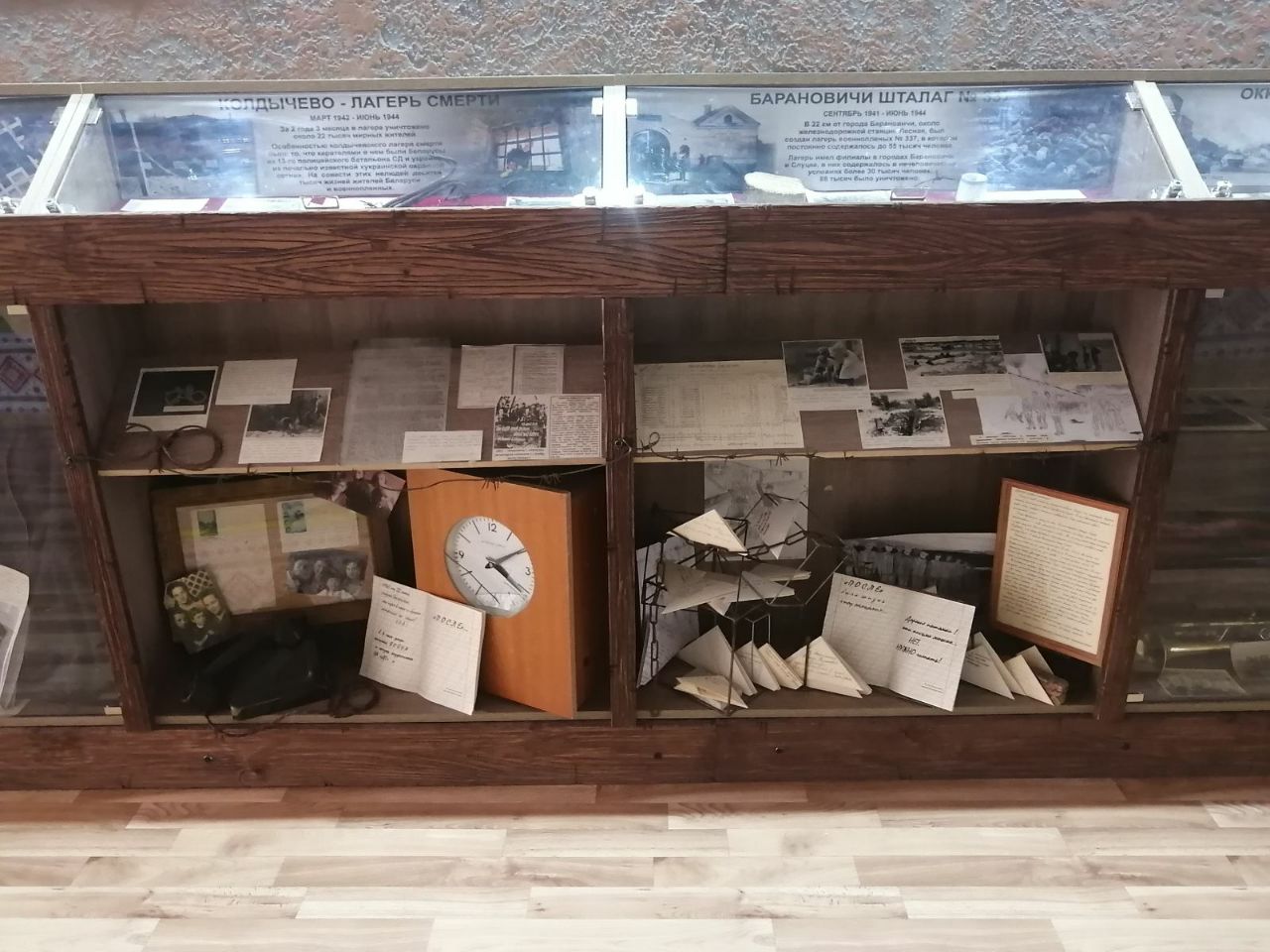
El 27 de juniode 1941, los fascistas entraron en nuestra ciudad y también ocuparon el territorio del distrito de Baranovichi. Desde los primeros minutos, los fascistas demostraron que ellos eran los dueñosaquí. Estaban ubicados en los mejores edificios de la ciudad y determinaban el destino de la ciudad y de sus habitantes.
En ese tiempoterrible, los habitantes de nuestra ciudad y sus alrededores sintieron lo que significaba ser representante de una «raza inferior».
El 28 de junio de 1941, en dos horas, todos los judíos de la ciudad de Baranovichi fueron desalojados por la fuerza al así llamado «Sakhalin» (una zona cercana a la actual Planta de productos químicos domésticos). Les permitieron llevar consigo solo un paquete de artículos de primera necesidad. Todos se vieron obligados a dejar todos los bienes adquiridos. El signo hecho de tela amarilla ponía a los judíosfuera de ley: nadie era responsable de sus palizas, robos o asesinatos.
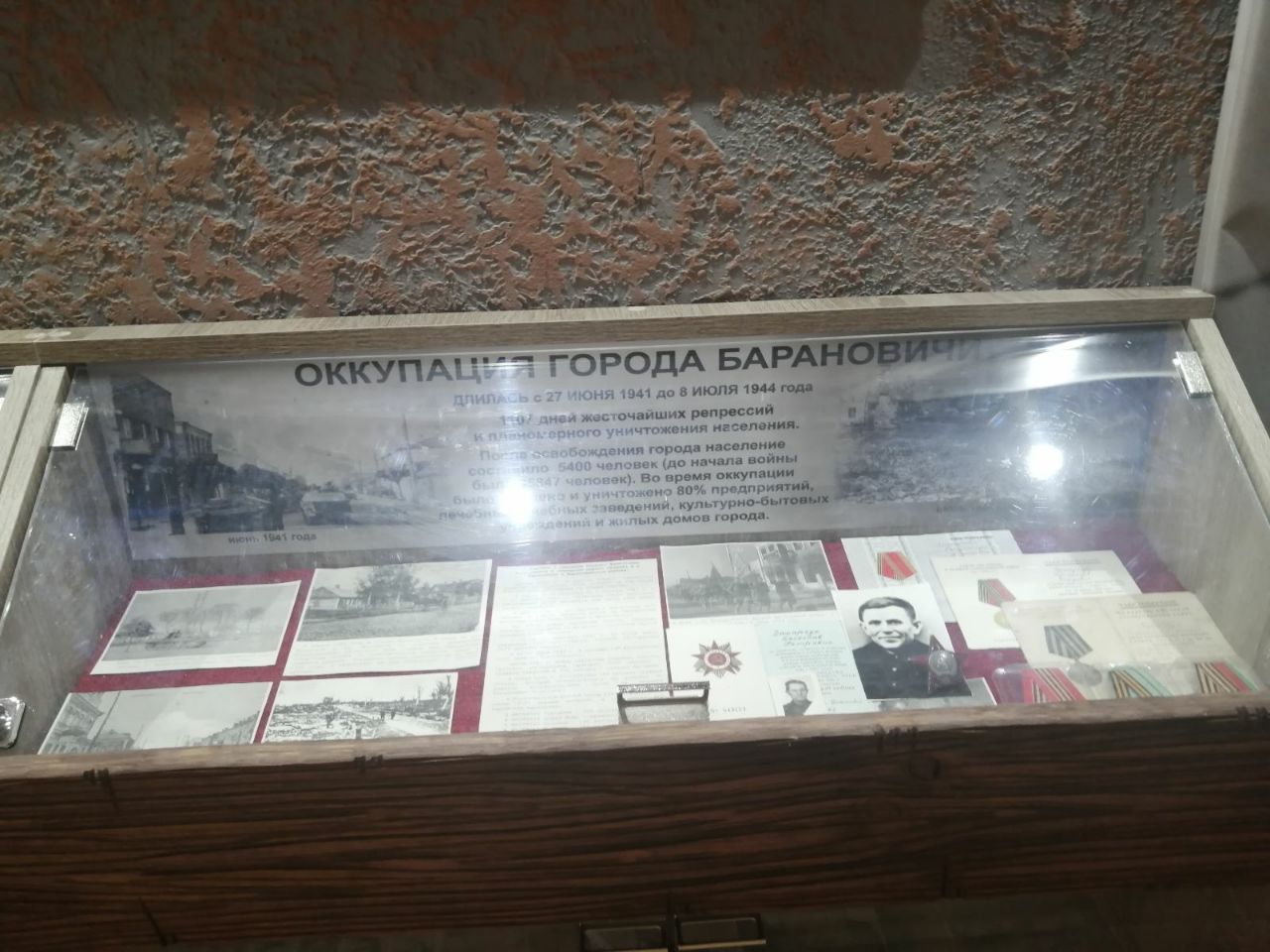
En diciembre de 1941 fue creado un gueto judío en Baranovichi. Los judíos fueron reunidos en un área determinada. El gueto ocupaba 11 cuadras de Baranovichi y se limitaba a las calles modernas de Gagarin, Komsomolskaya, Lisin, Bogdanovich. El portal fue construido en el cruce de las actuales calles Gritsevets y Mitskevich, donde ahora se encuentra una empresa afillada de la asociación de producción de juguetes «Mir».
Los judíos podían llevar al guetosólo una maleta con sus pertenencias personales. Se les prohibía salir de la zona del gueto sin un permiso especial, por ende privando de la oportunidad de ganar un trozo de pan. A los judíos se les prohibía caminar por las aceras, sino sólo en medio de la calle; se les prohibía utilizar el transporte público o estar en parques o lugares públicos. Los judíos debían llevar un signo distintivo de color amarillo en forma de estrella de David de seis puntas en ambos lados de la ropa (por delante y por detrás). El gueto estaba acordonado con dos hileras de alambre de púas y estrictamente vigilado. En diciembre de 1941en gueto había 15.000 personas.
«La gente en el gueto siempre tenía hambre. Los alemanes mataron de hambre a los habitantes, permitiéndoles comprar sólo una cantidad limitada de pan y patatas. Algunos lograron ahorrar algo de dinero u objetos de valor y los cambiaban por comida llevada a escondidas en el gueto».
De los recuerdos de la prisionera superviviente del gueto de Baranovichi E.A. Madresh:
«A pesar del sufrimiento y la muerte, los niños del gueto continuaron jugando con juguetes, haciéndolos ellos mismos, de cualquier trozo de tela y pedazo de madera que pudieran encontrar».
A los prisioneros fugitivos de campos de concentración y guetos salvaban los sacerdotes de iglesias ortodoxas y sacerdotes de iglesias católicas.
Pero esto no fue suficiente para los fascistas: aniquilaron casi toda la población judía de nuestra ciudad y de los pueblos y ciudades de la región de Baranovichi.
A finales de diciembre de 1942, a la entrada de la ciudad de Baranovichi, fue instalado el signo Judenfrei «JU D E N R A Y N» («Libre de judíos»).
En total, del gueto de Baranovichi fueron exterminadas 18.750 personas, ciudadanos soviéticos de nacionalidad judía, incluido 12.000 habitantes de Baranovichi.
El 23 de diciembre de 2002, en el parque cerca de la Casa de los oficiales, donde pasaba la frontera del gueto, fue inaugurado un cartel en memoria de los doce mil habitantes de Baranovichi que murieron en el gueto: 12 hojas de arce caídas de metal , esparcidas alrededor de un enorme rodado, guardan la memoria de los 12 mil judíos fusilados.
El Holocausto es una página terrible en la historia de la humanidad. Los nazis llevaron a cabo el asesinato de millones de judíos en toda Europa. Pero en aquellos «tiempos oscuros de la humanidad» tenía lugar el heroísmo. Estos eran los Justos de las Naciones. El Talmud, uno de los principales libros del judaísmo, afirma que «quien salvó una vida, salvó al mundo entero». Más de 680 personas han sido reconocidas como justos por salvar a los judíos en el territorio de la actual Belarús. En la región de Brest, este título fue otorgado a 27 habitantes, siete de ellos son residentes de Baranovichi: Chasha Eduard; Anna Kazakevich; Slizen Leopoldo; Mandel Tatiana; Abramova Galina; Malinovsky Roman; Malinovskaya Sofía.
Los nombres de las personas otorgadas de este alto título están inscritos en el Muro de Honor en el Jardín de los Justos de las Naciones en el Museo Memorial en memoria de los judíos que fallecieron durante la guerra. En honor a cada persona a la que se le otorga este título, se planta un árbol en el Callejón de los Justos de las Naciones, en el que se instala una placa conmemorativa con la historia de un hombre notable que estaba en peligro y que vivía en constante miedo, pero a pesar de todo salvaba a los judíos de la muerte.
Recorrido por la exposición del Liceo №1 (parte 3)
El testimonio indiscutible de la política de genocidio fueron dos campos de concentración que existían cerca de Baranavichy. Este es el campo de exterminio de Koldychevsky y Shtalag-337.
A los15 kilómetros de la ciudad de Baranovichi, en el territorio de la antigua finca de panesen el pueblo de Koldychevo, desde el marzo de 1942 hasta el julio de 1944, funcionó un campo deconcentración creado por los fascistas para los habitantes civiles. Durante los dos años de existencia del campo de concentración, murieron allí unos 22 mil civiles, habitantes de la ciudad de Baranovichi y de la región de Baranovichi. En nuestra exposición hemos colocado modelos de tiras que llevaban los prisioneros de este campo. Después de llegar al campo, los prisioneros tuvieron que coser signos especiales en sus ropas, diferenciándolos según el grado de amenaza para las autoridades de ocupación. Las insignias se llevaban en la espalda y el pecho, y los hombres, además, en el lado derecho del pantalón. El grado de amenaza estaba determinado por el número de franjas claras. El azul oscuro con una franja clara, sospechoso de conexiones con guerrilleros, con dos franjas, estaba relacionado con guerrilleros, con tres franjas, guerrilleros; una mancha negra con un hexágono amarillo significaba «judío».
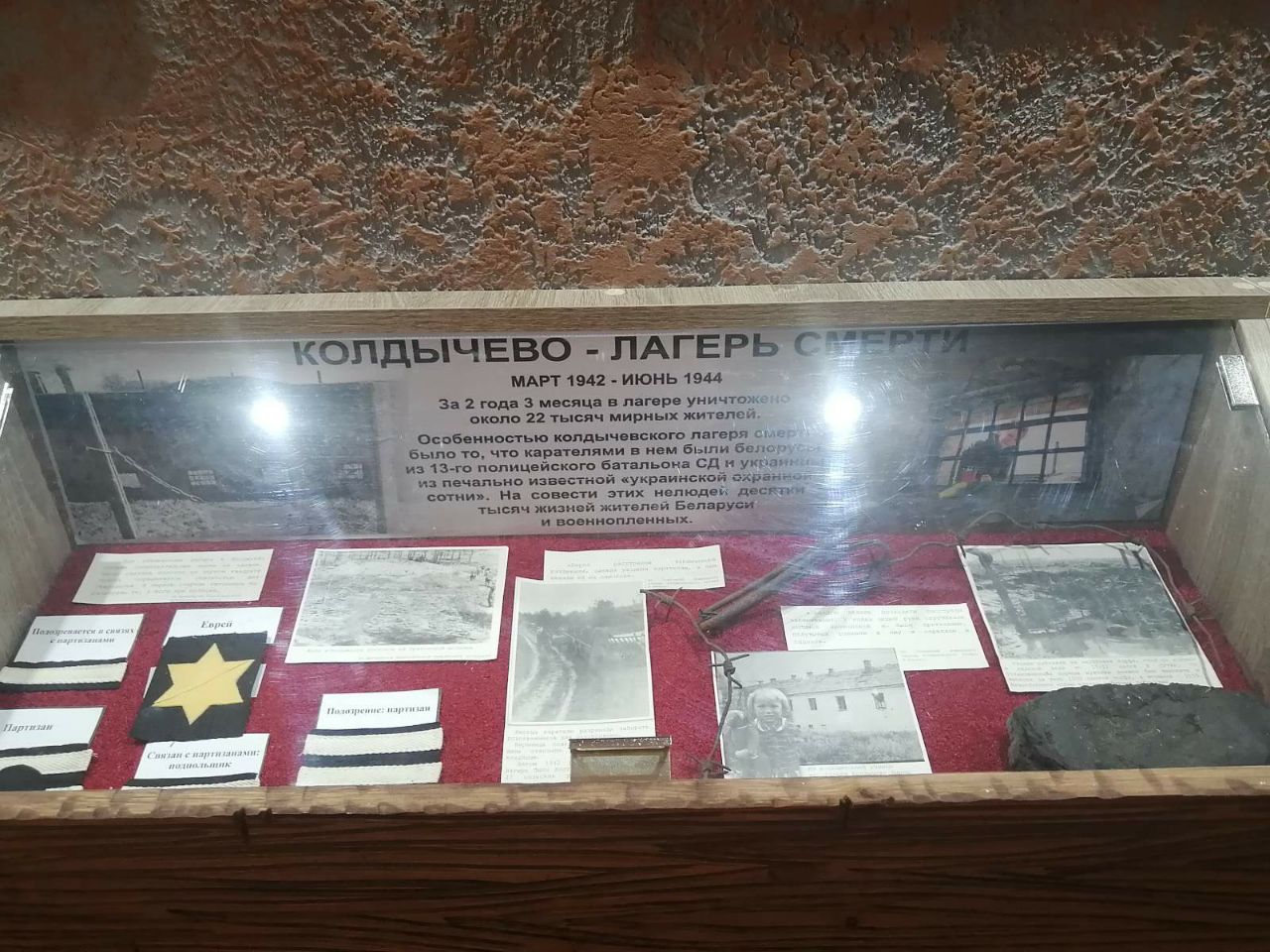
¿Por qué caía la gente pacífica al campo? Por el hecho de que sus familiares fueron al frente o se unieron a los destacamentos guerrilleros, por los uniformes del Ejército Rojo que no fueron entregados a los nazis, por aparecer en la calle después de las 8 en punto, por no querer inclinar sus orgullosas cabezas ante a los ocupantes, por cualquier «delito», y luego sin motivo alguno. En el verano de 1942, 13 sacerdotes y 37 profesores polacos fueron llevados al campo de Koldychevsky. Todos fueron fusilados.
La zona del campamento estaba vallada en varias hileras con alambre de púas y equipada con nidos para ametralladoras. Por la noche, la seguridad se reforzó con puestos de tiro adicionales y unidades de patrulla alrededor del campamento, y fue proporcionada por búnkeres y tanques excavados en el suelo.
Los prisioneros de los campos estaban alojados en cuarteles y pertenencias. La prisión especialmente construida tenía 12 celdas. Alrededor del 60% de los prisioneros del campo de Koldychevo estaban al aire libre.
Los prisioneros del campo de Koldychevo trabajaban en las industrias del ladrillo, del jabón y de la tonelería, así como en el campo y en la extracción de turba, y cargaban metal y materiales de construcción. La jornada laboral en Koldychevo era de 10 a 12 horas. El levantamiento del campamento se produjo a las 6 de la mañana. Después del levantamiento se llevaba a cabo la inspección de los prisioneros. En total se realizaron al menos 9 controles durante la jornada. Todos ellos estuvieron acompañados de palizas y abusos a los prisioneros. El comandante y los guardias vivían en una casa de madera de dos pisos al lado de la prisión. Aquí también se encontraban cámaras de tortura, donde las víctimas eran sometidas a terribles torturas. Les puncionaban la lengua, les clavaban agujas debajo de las uñas, les colgaban, les estiraban los músculos, les rompían los dedos de las manos y de los pies, los golpeaban con porras de goma, les vertían agua en la nariz, les apretaban la cabeza con una máquina especial, les cortaban pedazos del cuerpo con cuchillos y picaban con bayonetas, con los pies descalzos les colocaban sobre una sartén caliente, arrancabanel pelo, aperreaban perros especialmente entrenados.
Del testimonio del comandante de seguridad del campo de Koldychevo, N. Kalko:
«Antes de la ejecución, desnudaban a los prisioneros, sus ropas tomaban los castigadores y las cambiaban por aguardiente casero».
«...cada semana ejecutaban a los prisioneros. A las personas desnudas les retorcían las manos con alambre de púas y las golpeaban con las culatas de los rifles; a las personas medio muertas las empujaban a un foso y les disparaban en la cabeza».
De los recuerdos del poeta bielorruso Sergei Novik-Pyaun:
«No tengo fuerzas para describir todos los horrores, acosos y torturas que tuve que soportar en las mazmorras del SD. Cómo sobreviví, cómo soporté todo, no lo puedo explicar. Un alemán me presentó burlonamente al comandante de seguridad del campo a Nikolai Kalko: «Mire, señor teniente, aquí hay un poeta ruso». Y enseguida empezó la paliza. En la «sala de recepción» colgaban de la pared porras de goma de varios tamaños, como salchichas en una carnicería».
En el lugar de la fosa común, donde fueron fusilados los últimos mil prisioneros antes de la retirada, fue erigido el monumento con la forma de una escultura de una Madre afligida. Pero en los bosques cerca de Koldychevo, los investigadores soviéticos encontraron en 1945 otras 15 tumbas similares. El 3 de julio de 2007, en el kilómetro 15 de la carretera Baranovichi-Novogrudok, a la entrada del bosque Mikhnovichi, entre las aldeas de Koldychevo y Mikhnovshchina, por decreto del presidente, se inauguró el cartel conmemorativo «Muro de las Lamentaciones». El monumento es un arco de tres hojas en el que están instaladas la estrella de David, cruces ortodoxas y católicas.
ARMARIO 3. STALAG 337
Stalag 337 fue uno de los campos más grandes para prisioneros soviéticos, creado por los fascistas en septiembre de 1941. Estaba ubicado en el área de la estación Lesnaya, una sucursal del campo estaba ubicada en la prisión de Baranovichi. Los alemanes llamaron campos estacionarios para prisioneros de guerra Stalags. Durante tres años, 88.407 prisioneros de guerra y civiles soviéticos murieron en el campo.
Las condiciones de los campos y el trato a los prisioneros estaban deliberados para matar la voluntad de resistir, humillar la dignidad humana y exterminarlos físicamente. Las áreas del campamento fueron cercadas con varias hileras de alambre de púas y se instaló seguridad reforzada mediante reflectores y perros especialmente entrenados.
A los prisioneros se les prohibió comunicarse con el mundo exterior y no se permitieron los envíos de alimentos. Por intentar obtener comida o ropa, los prisioneros fueron fusilados.
De los recuerdos de S. Vysokinsky, habitante del distrito Novomyshsky:
«La gente entraban al cuartel uno por uno. Nos alimentaron con aguate y nos dieron 125 gramos de pan al día. Los prisioneros fueron sometidos a torturas sin precedentes».
La crueldad en los campos de concentración era bien recibida; para los nazis, las personas eran material biológico y había que liquidarlas. Los castigadores de la gente civil recibieron recompensas por sus atrocidades. Peroeljuiciojustosellevó acabo.
De los materiales de la Fiscalía Interdistrital de Baranovichi:
Los refugios en los que se alojaban los prisioneros de guerra eran inadecuados para vivir, húmedos y fríos. A los trabajos más difíciles enviaban a las personas mal vestidas y calzadas a la estación Lesnaya para cargar y descargar. Muchos murieron de congelación.
Los prisioneros de guerra a menudo sufrían edemas masivos por inanición, que generalmente terminaban con la muerte y enfermedades infecciosas. No había suficiente agua en el campo y los que intentaban conseguirla fueron sometidos a fuertes palizas.
El 9 de mayo de 2005, en el lugar de enterramiento de 31 mil prisioneros de guerra soviéticos que murieron en la prisión de Baranovichi, se inauguró el complejo conmemorativo «Memoria».
Recorrido por la exposición del Liceo No. 1 (parte 4)
(Los mapas de pueblos quemados)
Una de las formas de genocidio fue la política de quema de tierras seguida por los alemanes en los territorios ocupados. Durante el período de ocupación, se llevaron a cabo en Bielorrusia más de 140 importantes operaciones punitivas contra partisanos y civiles. Uno de los principales métodos y métodos para implementar la política punitiva de «tierra arrasada» fue la destrucción masiva de asentamientos junto con la población. Como regla general, los hitlerianos amontonaban a la gente en una casa, cobertizo o granero, la cerraban herméticamente y luego le prendían fuego.
Según la información recibida durante la investigación de la Fiscalía General de la causa penal por genocidio de la población de Bielorrusia, iniciada en abril de 2021, se publicaron mapas. Contienen información sobre la ubicación de los asentamientos en el territorio moderno de la República de Belarús, quemados por los ocupantes fascistas y sus cómplices durante la Gran Guerra Patria.

En esta parte de la exposición vemos un mapa que realmente arde según el número de pueblos quemados en Bielorrusia marcados con puntos rojos. Las siguientes cifras hablan de la escala de la destrucción de las zonas pobladas de Bielorrusia por parte de los invasores fascistas junto con sus residentes: las fuerzas punitivas quemaron más de 9.000 (!) asentamientos rurales. Muchos no fueron revividos. Los fascistas destruyeron casi 5.300 pueblos y aldeas, incluyendo todos o parte de sus habitantes.
La Gran Guerra Patria dejó una huella terrible en la tierra de Baranovichi. Barrió pueblos pacíficos como un tornado de fuego, destruyendo a la gente y quemando todo lo que los aldeanos laboriosos habían creado. En la región de Brest, durante la Gran Guerra Patria, las fuerzas punitivas quemaron 786 aldeas, en la región de Baranovichi - 56 aldeas. El segundo mapa muestra los pueblos quemados de la región de Baranovichi, el número de casas y personas que estaban allí antes de la guerra, cuántas casas fueron destruidas y cuántas personas murieron. La cuarta generación no conoce la guerra aquí. Pero el recuerdo del terrible pasado vive en nuestros corazones.
ARMARIO 4. OCUPACIÓN DE BARANOVICHI
Esta parte de la exposición nos relata de los horrores de la ocupación de nuestra ciudad, aquí están expuestas fotografías, testimonios, documentos, objetos personales de los participantes de aquellos acontecimientos.
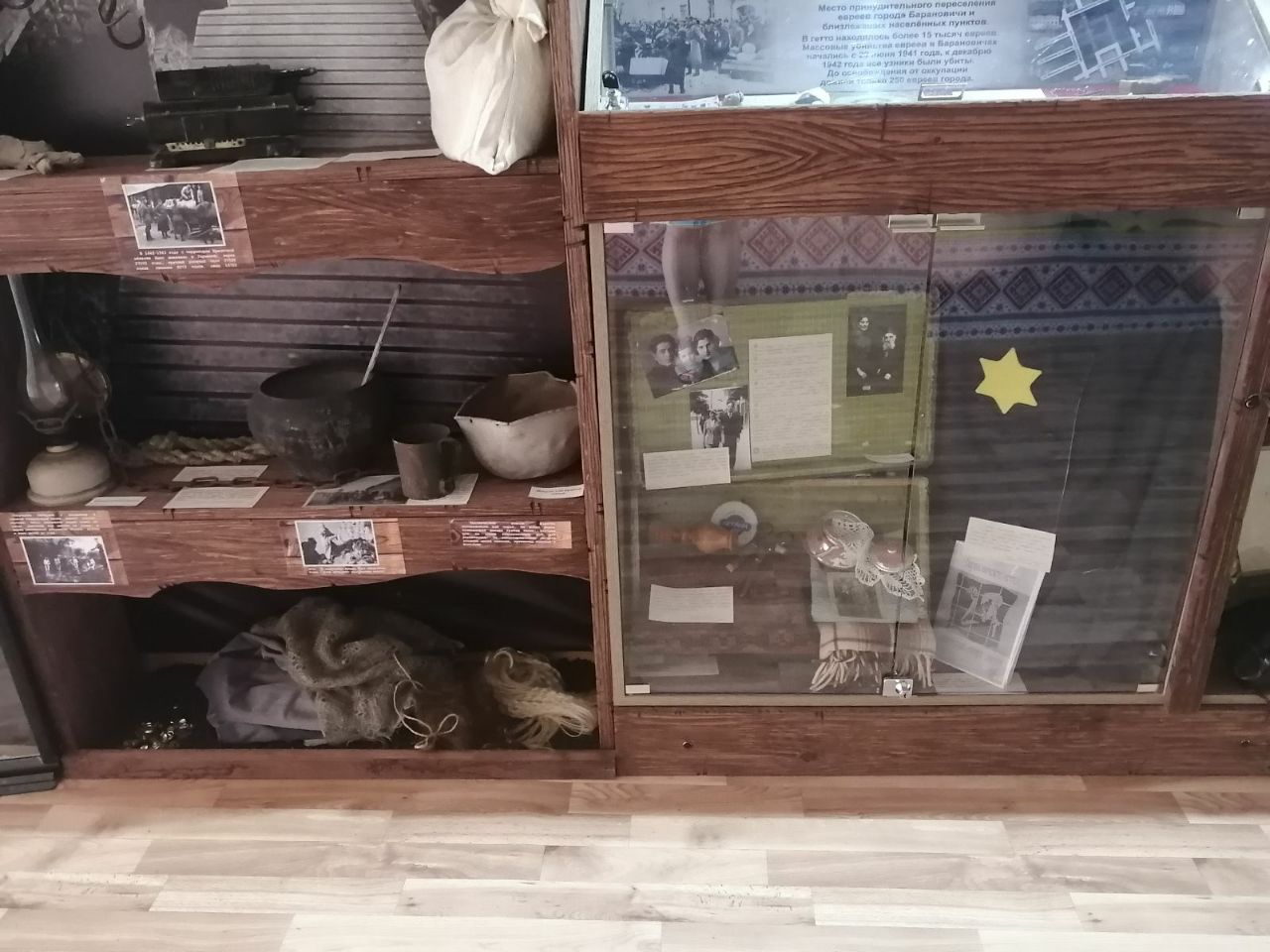
En abril de 1942 en la ciudad de Baranovichi en casas en la calle Vilenskaya y Shosseynaya, siguiendo instrucciones del jefe de Baranovichi SD-Gestapo, se crearon dos puntos especiales de selección para el envío forzoso de personas a la esclavitud alemana. Estos puntos existieron hasta el junio de 1944 y cada mes de ellos enviaban entre 300 y 400 personas. Desde la ciudad de Baranovichi, según datos incompletos, 7.593 personas fueron enviadas al trabajo penoso en Alemania.
Según la Comisión Estatal de Contabilidad de los Daños Causados por los Invasores fascistas, en el territorio de la antigua región de Baranovichi destruyeron:
181.179 civiles,
88.407 prisioneros de guerra soviéticos,
33.773 habitantes fueron llevados a la esclavitud alemana.
Vemos cifras terribles en la «Información sobre el genocidio de los invasores nazis contra civiles en la ciudad de Baranovichi y la región de Baranovichi».
Después de la guerra, en enero de 1962, en la ciudad, en la sala de la Casa de Oficiales, se celebró un juicio contra 4 criminales nazis, guardias del campo de Koldychevsky. De toda Bielorrusia llegaron testigos de los crímenes de los fascistas. A juzgar por la foto, no había asientos vacíos en la sala. Las atrocidades que cometieron los acusados y sus colegas durante la guerra están bien conservadas en la memoria de la gente. Más de cincuenta testigos atestaron en el juicio. Durante seis días la gente siguió el proceso y exigió la pena de muerte. Después de todo, no podía haber otra sentencia para los verdugos. Los registros digitalizados de este juicio se conservan en el Museo de Etnografía Territorial de Baranavichy.
La ciudad de Baranovichi fue liberada el 8 de julio de 1944. Se puede decir que la Gran Guerra Patria destruyó casi por completo la ciudad de Baranovichi de anteguerra. El 80% de todos los edificios de la ciudad fueron destruidos. El ferrocarril, la central eléctrica, casi toda la industria de la ciudad, 2,5 mil edificios residenciales, un teatro, un cine, seis escuelas, una de las estaciones de radio más grandes del país fueron destruidos, un museo fue saqueado... La población de anteguerra se contaba con 26 mil personas y solo un poco más de 5 mil ciudadanos recibieron a sus libertadores: las tropas del 1er Frente Bielorruso bajo el mando del mariscal de la Unión Soviética K.K. Rokossovsky. Al mismo tiempo, se distinguieron las tropas del 28.º Ejército bajo el mando del teniente general L.A. Lupinsky y del 65.º Ejército bajo el mando del coronel general P.I. Batov. Los guerrilleros de la unidad de Baranovichi también entraron con las tropas en la ciudad liberada.
Y ahora quiero relatarles de un hombre, un veterano de la Segunda Guerra Mundial, cuyas pertenencias personales se muestran en nuestra exposición.
Vladimir Ivanovich Sazanovich
Nacido el 2 de agosto de 1922 en el pueblo de Slonevo, distrito de Novogrudok. Estudió en una escuela polaca, se graduó en octavo grado y allí aprendió a tocar el violín.
En 1944, después de la liberación de Bielorrusia, él y sus dos hermanos fueron reclutados por el Ejército Rojo. Liberaba la ciudad de Königsberg (hoy Kaliningrado). En el ejército era operador de radio y mantenía la comunicación entre el Estado Mayor del Regimiento y la unidad que avanzaba. Durante la ofensiva, esta comunicación se interrumpió y, junto con el comandante de la unidad, Vladimir fue a restablecerla y fueron atacados por un proyectil. El comandante murió y Vladimir resultó herido en una pierna. Le vendaron la pierna, le dieron un palo en las manos y le dijeron que caminara a la retaguardia. Lo recogieron en la retaguardia y fue llevado al hospital. Como sangraba mucho, perdió mucha sangre. Una enfermera aceptó darle una transfusión de sangre y fue salvado. En el hospital, un oficial tenía un trofeo: un violín alemán. Vladimir lo tocaba a menudo para los heridos, y cuando fue dado de alta del hospital, recibió este violín como regalo.
Al pasar muchos años, con la ayuda de la Cruz Roja, Vladimir encontró a la enfermera que le salvó la vida. Fue a Moscú para verse con ella y agradecerla. Ganaba la vida tocando el violín. Hoy su violín tiene más de 100 años y lo conserva su bisnieto..
Después de la guerra, Vladimir se casó y tuvo dos hijos. Trabajó de cartero, sastre y los fines de semana tocaba el violín en bodas en toda la región de Novogrudok. Vladimir Ivanovich vivió una vida larga e interesante. Falleció el 3 de septiembre de 2009 a la edad de 86 años.
Vladimir Ivanovich tenía 4 nietos y 7 bisnietos. Dos nietos, Inna y Alexander Sazanovich, se graduaron el Liceo en 1991 y 1997. Sus bisnietos María y Nikolai Bondar estudian aquí, e Ivan Bondar continúa la tradición y estudia en Liceo en el grado 8-1.
En abril de 2021, la Fiscalía General inició un proceso penal por el hecho de genocidio de la población de Belarús durante la Gran Guerra Patria y la posguerra. Los empleados de la fiscalía encontraron miles de pruebas documentales de las atrocidades del fascismo y entrevistaron a cientos de bielorrusos. En la labor de recogida de pruebas también participó activamente la Fiscalía interdistrital de Baránovichi. Durante la investigación de esta causa penal se identificaron 26 lugares en la región de Brest en los que presuntamente podrían ser enterradas víctimas de la guerra, cuya información hasta entonces era desconocida.
En la región de Brest siguen revelando nuevas pruebas del genocidio del pueblo bielorruso durante la Gran Guerra Patria. Sólo en el distrito de Baranovichi se encontraron tres lugares de exterminio masivo de civilesno registrados anteriormente por parte de fuerzas punitivas. Uno de ellos está en una zona forestal cerca del pueblo de Tartaki. Ahora los militares del 52º batallón de búsqueda independiente del Ministerio de Defensa están realizando excavaciones allí y los fiscales están llevando a cabo las investigaciones necesarias. La búsqueda de testigos y el estudio de documentos de archivo realizados anteriormente por la fiscalía ayudaron a establecer un nuevo hecho de las atrocidades cometidas por los ocupantes.
Nosotros vivimos en un país pacífico, tomamos la vida pacífica como un echo. Pero no siempre era así. Los bielorrusos son una de las naciones más dañadas por la Gran Guerra Patria. Al ocupar el territorio de Bielorrusia en el verano de 1941, los invasores fascistas comenzaron a aplicar una política de genocidio destinada a exterminar al pueblo bielorruso. Como resultado del genocidio en el territorio de la BSSR, murieron más de 2 millones 200 mil de ciudadanos soviéticos. Más de 377 mil ciudadanos fueron llevadosa Alemania bajo amenaza de muerte, muchos de los cuales murieron en resultado de condiciones de trabajo insoportables, privaciones y abusos.
Esto no se puede olvidar. Esto no se puede perdonar. Es necesario recordar esto. Por eso, el 5 de enero de 2022 fue aprobado la Ley de la República de Belarús «Sobre el genocidio del pueblo bielorruso».
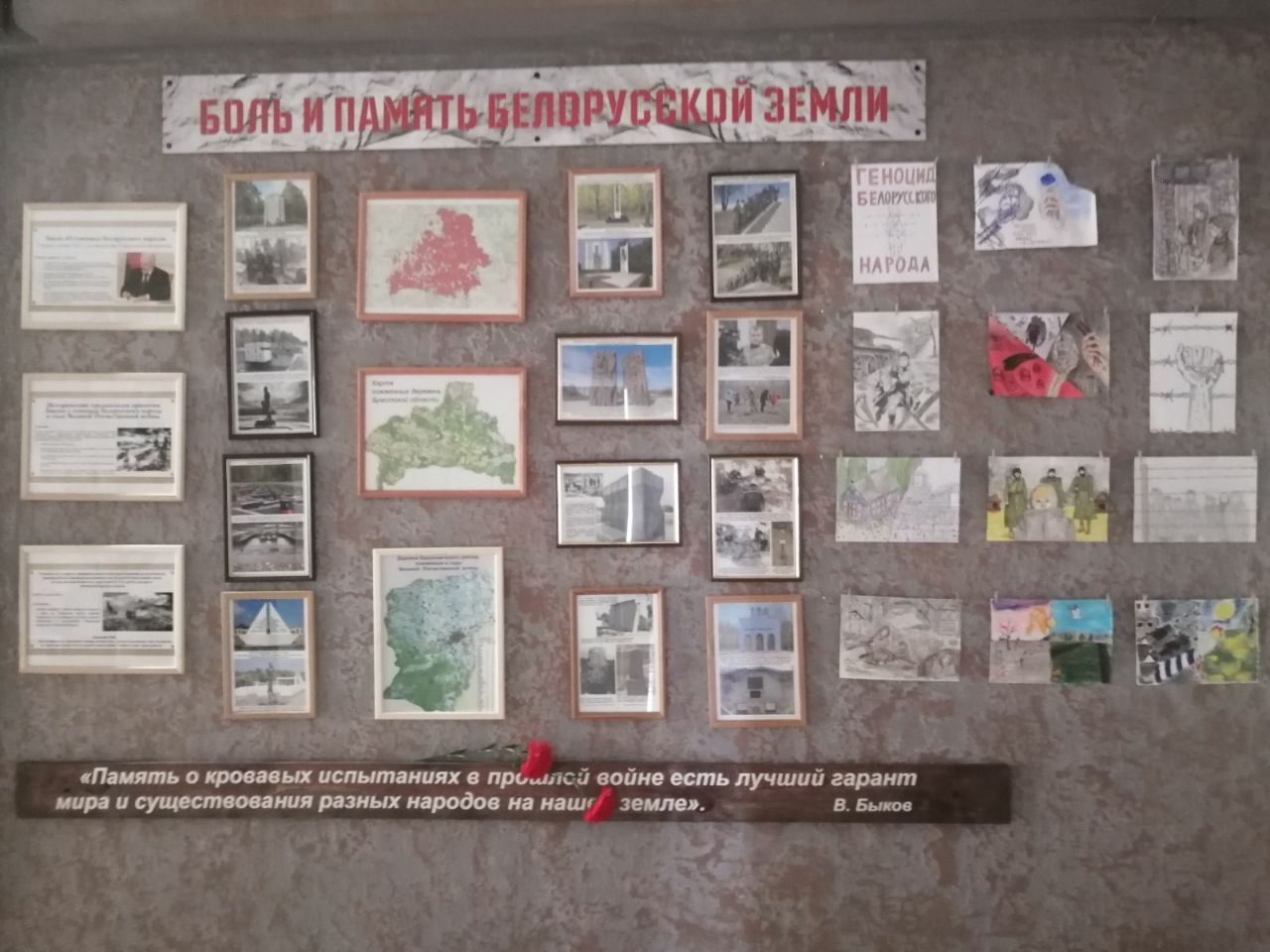
Al final de nuestra exposición colocamos fotografías de los monumentos y memoriales más notables de la Gran Guerra Patria, que guardan la verdad de aquella guerra lejana para las generaciones futuras. También aquí se encuentran dibujos de alumnos de nuestro Liceo, en los que los niños expresaron su empatía por sus antepasados, su actitud y emociones ante aquellos trágicos momentos de nuestra historia. ¡Gracias por su atención!